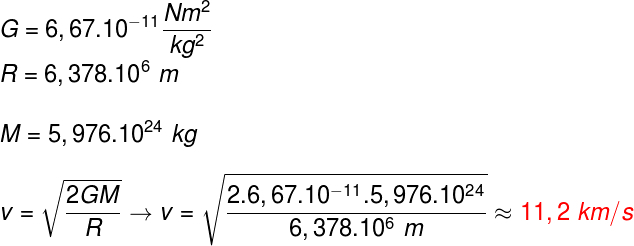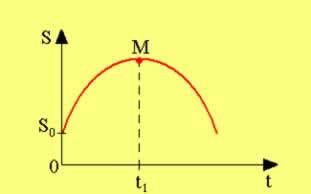O principleinArchimedes claims that the strength of buoyancy acts vertically and upwards on bodies fully or partially immersed in fluidsFurthermore, according to this principle, such force has the same value as the weight of the fluid, displaced by the insertion of the body.
Lookalso: Hydrostatics – everything you need to know: formulas, examples and exercises
History of Archimedes' Principle
Archimedes of Syracuse was one of the biggest mathematicians and inventors of all time, however, his most famous discovery was the strengthinbuoyancy. According to legend, Archimedes discovered the principle of buoyancy while taking a bath in his bathtub.
On that occasion, he realized that the volumeinWaterflowing out from your bathtub was equal to the immersed volume of his own body. According to the story, Archimedes was said to have been so excited by his discovery that he jumped out of his bathtub and ran naked through the streets screaming “Eureka,andureka!" (Greek expression about the sage having found something).
Another narrative reports that Archimedes was requested by the king Hieron II to investigate the composition of a crown he had commissioned. The king had ordered his crown to be made of solid gold, but on receiving it he suspected that other metals might have been used in his forge. To clear his doubts, he asked Archimedes to find out if his crown was pure gold or not.
Archimedes successively dipped the crown and two massive objects made of pure gold and silver into a vessel filled with water. weights they were exactly the same as the crown. By doing this, he realized that the crown spilled less liquid than the gold, but more liquid than silver, which suggested that Is it over there no it was purely composed of gold.

Buoyancy and the Archimedes Principle
According to Archimedes' principle:
"Any object, fully or partially immersed in a fluid or liquid, is propelled by a force equal to the weight of the fluid displaced by the object."
Do not stop now... There's more after the advertising ;)
As we have seen, the force described by Archimedes' principle is now known as the buoyant force. This force is equal, in module, to the weight of the fluid, which is displaced when we insert a body into it. It is this force that makes the ships do not sink or even that we are able to float on water.

thrust formula
We know that buoyancy equals the weight of the fluid displaced by the presence of an immersed object. That said, if we remember the relationship between the pasta of the fluid, your density and its volume, we can write the buoyant force in terms of these greatnesses, thus facilitating the calculation of this force. The formula used to calculate the buoyant force is shown in the following figure, check it out:

AND – thrust (N)
d – fluid density (kg/m³)
g – gravity acceleration (m/s²)
V – volume of fluid displaced (m³)
Regarding the previous formula, it is important to remember that the volume of fluid displaced is equivalent to the immersed volume of the object, in addition, remember that the density used in the formula refers to the densityoffluid and not that of the immersed object.
See too:Pascal's Principle – definition, formulas, examples, applications and exercises
Exercises on Archimedes' Principle
Question 1) (Enem) During construction work on a club, a group of workers had to remove a massive iron sculpture placed at the bottom of an empty swimming pool. Five workers tied ropes to the sculpture and tried to pull it up, without success. If the pool is filled with water, it will be easier for workers to remove the sculpture, as the:
a) sculpture will float. That way, men won't need to strain to remove the sculpture from the bottom.
b) sculpture will be lighter in weight. In this way, the intensity of force required to lift the sculpture will be lower.
c) water will exert a force on the sculpture proportional to its mass, and upwards. This force will be added to the force that the workers make to cancel the action of the weight force of the sculpture.
d) water will exert a downward force on the sculpture, and it will receive an upward force from the pool floor. This force will help cancel out the action of the weight force in the sculpture.
e) water will exert a force on the sculpture proportional to its volume, and upwards. This force will add to what the workers do, and may result in an upward force greater than the weight of the sculpture.
Template: Letter e
Resolution:
The force that the pool water exerts on the sculpture depends on its volume. This force, in turn, acts in the vertical direction, points upwards, and is equal, in module, to the weight of the water displaced by the statue, which facilitates its removal, therefore, the correct alternative is the letter e.
Question 2) (UPF) The strip below shows an iceberg that has its volume partially immersed (9/10 of its total volume) in seawater. Considering that the density of seawater is 1.0 g/cm³, check the alternative that indicates the density of the ice, in g/cm³, which makes up the iceberg.
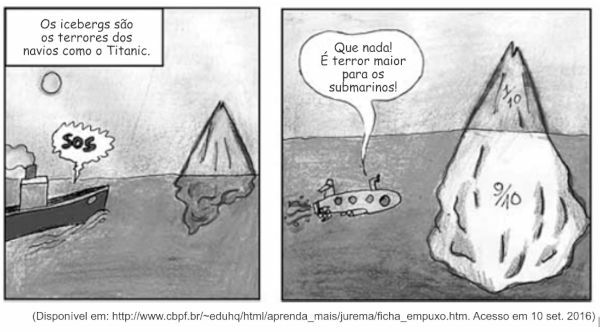
a) 0.5
b) 1.3
c) 0.9
d) 0.1
e) 1
Template: Letter C
Resolution:
Since the weight of the iceberg is equal to the weight of water displaced by the iceberg itself, we must perform the following calculation:
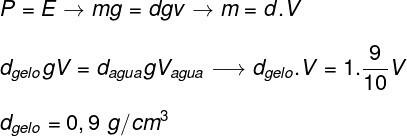
Question 3) (UFPR) A solid object with a mass of 600 g and a volume of 1 liter is partially immersed in a liquid, so that 80% of its volume is submerged. Considering the acceleration due to gravity equal to 10 m/s², mark the alternative that presents the specific mass of the liquid.
a) 0.48 g/cm³
b) 0.75 g/cm³
c) 0.8 g/cm³
d) 1.33 g/cm³
e) 1.4 g/cm³
Template: Letter B
Resolution:
First, we need to remember that if the body is floating, its weight is equal to the buoyant force, so:
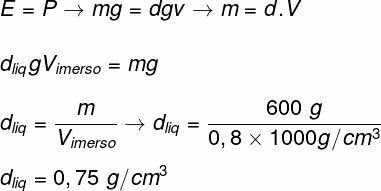
By Rafael Hellerbrock
Physics teacher


